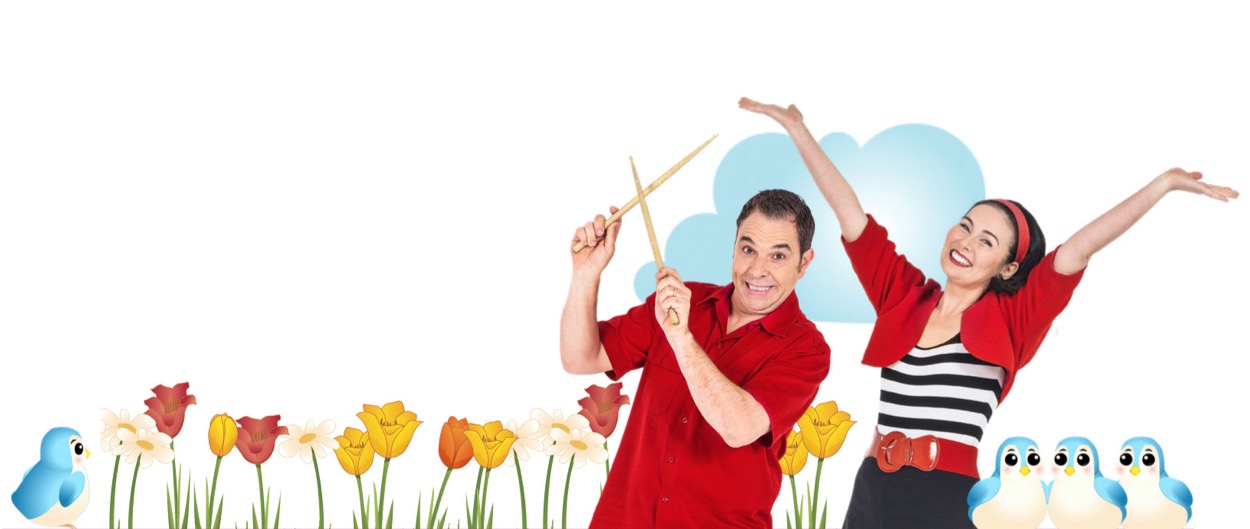

Rhythm is the organisation of sounds in time.
Rhythms can be regular like a beat, or irregular. Sounds in rhythms can be long or short, and they can be close together or further apart with silences in between. Through their fun and catchy songs, the Big Live Band explore all these combinations - and more!

- Listen for, move to, and play the steady beat in music
- Understand that ‘beat’ is a steady rhythm.
- Repeat and compose rhythms
- Understand that music is made up of long sounds, short sounds, and silences.

Clap a series of simple rhythms for your students to repeat.
Teachers often clap like this to get your attention, but did you know echo clapping actually involves hearing and playing a rhythm? Can you repeat a rhythm you’ve heard, or make up your own?
Have students take turns at clapping a simple rhythm for their classmates to repeat.
Teacher Tutorials
Explainer
Elaboration
Extension
Music Clips
Woody the Woodwind
Boom Chaka
Band on the Bus - Helen the Opera Singer
Lessons
Lesson 1
WALT: Listen for and move to the beat in music.
Discussion starter
Have you ever heard your heartbeat through a stethoscope? What does it sound like? It has a regular beat: thump-thump, thump-thump. The beat always stays steady, but it can speed up if you run around, and it slows down when you are calm.
The steady pulse in music is also called the ‘beat’. It's a regular kind of rhythm that we can hear or feel.
Just like a heartbeat, the beat in music can only be changed by speeding it up or slowing it down. The speed of the beat is called its tempo.
Learning task
Watch Lah-Lah’s Adventures clip ‘Woody the Woodwind’ with your class to see Lah-Lah, Buzz and the Big Live Band walking in time with the beat. Can you walk in time with the beat, too? When students are comfortable walking to the beat, they could try marching or jumping to the beat instead. What other ways can you move to the beat?
The beat changes in the second half of the song when the tempo slows for one verse. Can you slow down your movements to match the slower beat? As a fun variation for moving to the beat, students could sit in a circle and pass a ball to the beat.
Lesson 2
WALT: Play the beat in music.
Discussion starter
Turn to a partner on the floor, and tell them what you know about the beat in music. How did you and your partner describe the beat? We know that the beat is a steady rhythm that we hear or feel in music; it doesn't change, except for speeding up or slowing down.
Learning task
With students sitting on the floor, explain that instead of moving to the beat, they will now play the beat. We play the beat all the time without even realising it, like when we clap along to a song. Watch the ‘Woody the Woodwind’ clip again and ask students to pat their knees in time with the beat. Listen out for when the beat slows down; your patting will need to slow down too.
When students are comfortable with patting the beat, replay the clip and practise different ways to play the beat using body sounds, such as clapping, stomping, or clicking.
How else can you show the beat with your body? Can you sing the beat?
As a next step, students could play the beat to other familiar songs or nursery rhymes, or practise playing the beat on different instruments and classroom objects.
Lesson 3
WALT: Know the difference between the beat and rhythm.
Discussion starter
Beat is the steady pulse that we hear or feel in music; it's like a heartbeat, or a ticking clock. Can you clap a steady beat?
Beat is a steady rhythm, but rhythm doesn't always have to be steady. I'll clap a short rhythm that isn't regular or steady like the beat.
Rhythms are created every time you sing or play a group of notes one after the other. Rhythms occur in songs when you sing the syllables of words. For example, singing 'hap-py birth-day to you' makes a rhythm with six sounds.
Learning task
When you walked to the beat of ‘Woody the Woodwind’, the time between each step was the same because the beat is steady. In this next clip, Buzz and Lah-Lah move to the rhythm of the words instead of stomping to the beat. Their stomps aren't steady and evenly spaced because they are stomping in time with the words and the drums.
Watch the clip ‘Boom Chaka’, asking students to pay attention to Buzz and Lah-Lah’s stomping.
Can you copy this rhythm with your own stomping or with clapping? Can you sing and clap the rhythm of other songs you know? How would it look if you stomped to the beat of ‘Boom Chaka’ instead of the rhythm?
To continue learning about regular and irregular rhythms, students could pat their knees to create a steady beat while you chant a familiar nursery rhyme, such as 'Hickory Dickory Dock', and clap for each syllable.
The students will be patting the beat while you clap the rhythm. You could then swap roles, or have the class pat the beat while the other half claps the rhythm of the words.
Lesson 4
WALT: Listen for long sounds, short sounds and silences in music.
Discussion starter
Hum alternating long and short sounds for the class, and ask students to spot the difference between these sounds.
I was humming long sounds and short sounds. Can you make long and short sounds too? Rhythms are made up of long sounds, short sounds, and the silences between these sounds.
Let’s try the humming game again: this time hold your hands wide if you think I’m humming a long sound, and hold your hands close together if you think it’s a short sound.
Learning task
Watch the Lah-Lah’s Adventures clip ‘Band on the Bus – Helen the Opera Singer’ to illustrate what it means to sing long and short sounds. Long and short sounds can be hummed, sung, and played on instruments. Silence is when there is no sound.
Hold your hands wide apart or close together, asking students to respond with either a long or short sound. Do we have any instruments we could play long sounds on, like a recorder, or blowing through a cardboard tube?
After students have experimented with their voices and available instruments, explain that they will now play a game where a long sound means 'yes', and a short sound means 'no'. In pairs or small groups, have one student ask simple yes or no questions while others respond by singing long or short notes. Your students now have a secret code to use!
In following classes, students could listen carefully to the Lah-Lah’s Adventures songs from this and other units, and attempt to hear the long sounds, short sounds and silences in the music.
Assessment
What have you learnt about rhythm? What else would you like to know? What was easy for you, and what was challenging?
Do students move with an understanding of beat and rhythm? Can they explain the difference between the two? Can students play a steady beat through body percussion? Can they differentiate between long and short sounds in music? Can they repeat rhythms and create their own rhythms?
Assessment strategies include:
- Teacher observations
- Checklists for the target knowledge and skills
- Use a smart phone or tablet to record students playing the beat or rhythm, and singing long or short sounds.

